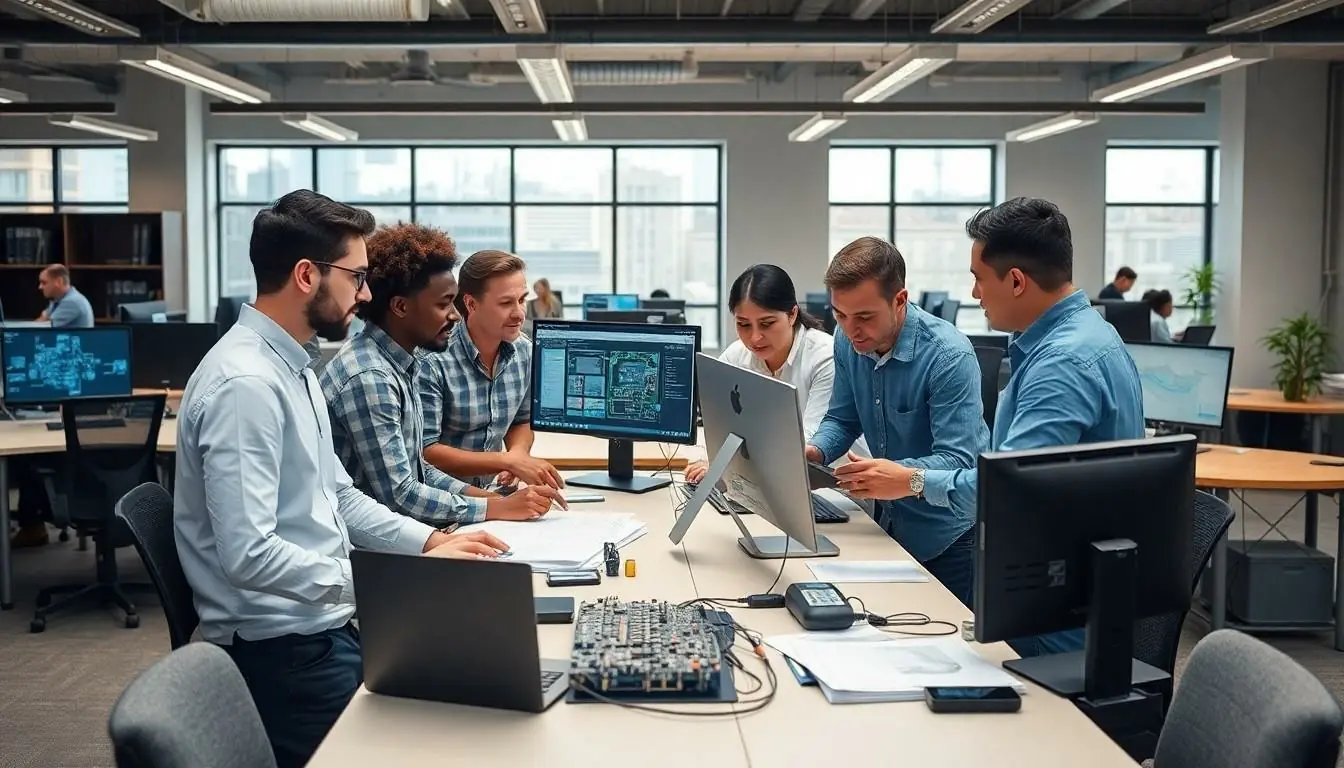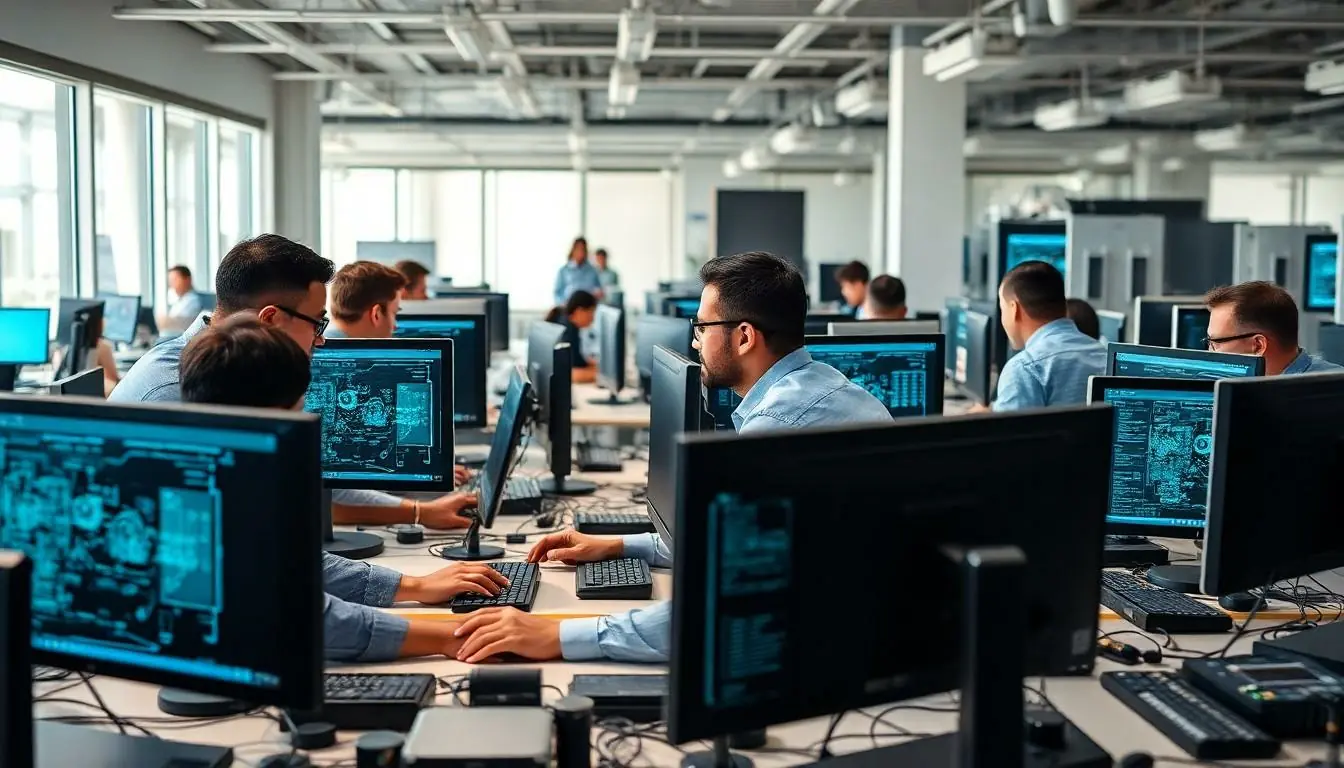Table of Contents
TogglePicture this: a world where gadgets come to life, and the hum of innovation fills the air. This is the daily grind of a computer hardware engineer. These tech wizards don’t just play with circuits; they design the backbone of the devices we can’t live without. From laptops to smartphones, their work environment is a blend of creativity and precision, where every component matters.
Overview of Computer Hardware Engineer Work Environment
Computer hardware engineers work primarily in engineering firms, research labs, and manufacturing facilities. They frequently collaborate with software engineers and other professionals to integrate hardware components with application requirements. Such collaboration fosters innovation and problem-solving in design and testing processes.
Laboratories serve as an essential aspect of their work environment. These spaces feature various tools and technology that enable engineers to prototype and test devices. Equipped with advanced testing equipment, engineers analyze performance metrics and ensure adherence to industry standards.
Office settings often complement laboratory work. In these environments, engineers engage in brainstorming sessions and project planning. Meetings with team members or clients enhance understanding and accountability throughout the project lifecycle.
Depending on the project, engineers may spend a significant amount of time at their desks. Concentration on design software and technical specifications is crucial for drafting schematics and circuit diagrams. Continuous learning and adaptation to new technologies characterize the work atmosphere, making it dynamic and fast-paced.
Flexibility defines many engineering roles. Some engineers work remotely or on hybrid schedules, allowing for a blend of collaboration and focused work time. Regardless of the setting, attention to detail remains paramount in the development of reliable hardware.
On occasion, computer hardware engineers visit production sites. This access provides insights into manufacturing processes and quality control measures. Such experiences contribute to a well-rounded understanding of the entire product development cycle.
Overall, the work environment for computer hardware engineers balances creativity, technical precision, and teamwork, fostering an atmosphere where innovation thrives.
Key Aspects of the Work Environment


Computer hardware engineers operate in diverse environments that reflect their focus on innovation and precision.
Office Setup
Collaboration thrives in open office spaces designed for teamwork. Engineers engage in brainstorming sessions to discuss project development. Each workstation typically features design software tailored for hardware architecture. Desks are equipped with technical resources for reviewing specifications and electronic schematics. Meetings occur regularly to align goals with other team members. Comfort is a priority, ensuring employees maintain focus during long hours of intense work. With access to high-speed internet and communication tools, productivity increases, enabling real-time discussions. Flexibility exists within these setups, allowing for remote work when necessary.
Laboratory Facilities
Laboratory facilities provide essential resources for testing and prototyping. Advanced equipment supports engineers in analyzing device performance, ensuring high standards are met. Workbenches host specialized tools for assembling and modifying components. Safety protocols maintain a secure environment while engineers conduct experiments. Collaboration often occurs in lab settings, allowing for the integration of hardware with software. Engineers frequently examine results to refine designs and troubleshoot issues. Continuous exploration of new technologies occurs in these facilities, promoting ongoing innovation. These environments emphasize the importance of rigorous testing, impacting the overall quality of products developed.
Tools and Technologies Used
Computer hardware engineers rely on various tools and technologies to excel in their work. These elements significantly contribute to their design and testing processes.
Design Software
Advanced design software plays a crucial role in hardware engineering. Programs like AutoCAD and SolidWorks enable engineers to create detailed schematics and 3D models of components. Engineers often use simulation software, such as Ansys, to predict how designs perform under various conditions. Collaboration tools, including Git and Jira, streamline project management and document changes. Each software application enhances the efficiency and accuracy of the design process, reflecting the engineer’s innovative capabilities.
Testing Equipment
Accuracy in testing is vital for computer hardware engineers. They frequently utilize oscilloscopes and logic analyzers to measure electrical signals and assess circuit functionality. Engineers apply multimeters for testing voltage, current, and resistance in components. Environmental testing equipment, including thermal chambers and vibration testers, ensures products withstand extreme conditions. By employing advanced testing systems, engineers can maintain high standards of quality, leading to improved product reliability and performance.
Collaboration and Team Dynamics
Collaboration plays a vital role in the work environment of computer hardware engineers. Team dynamics often involve frequent interactions and collective problem-solving to foster creativity.
Interaction with Other Engineers
Interaction with other engineers shapes daily activities for hardware engineers. Design engineers assess schematics, refining concepts through brainstorming sessions. Feedback from software engineers promotes device functionality, allowing hardware to integrate seamlessly with software applications. Cross-disciplinary collaboration enhances the overall design process. Engineers rely on each other’s expertise to troubleshoot issues, ensuring high-quality outcomes. Regular team meetings facilitate idea exchanges, keeping all members aligned on project timelines and objectives. Engaging with mechanical and electrical engineers broadens perspectives, driving innovative solutions.
Communication with Stakeholders
Effective communication with stakeholders remains crucial for project success. Hardware engineers translate complex technical details into understandable concepts for clients and product managers. Regular updates keep stakeholders informed on progress, addressing any concerns promptly. Engineers present design specifications, gathering feedback that shapes project direction. Collaboration with marketing teams ensures that product features align with market demands, enhancing user satisfaction. Maintaining strong connections with suppliers streamlines procurement processes, ensuring timely availability of components. Clear communication fosters a collaborative environment, ultimately benefiting product development and launch strategies.
Challenges Faced in the Work Environment
Computer hardware engineers encounter various challenges in their work environments that can impact their productivity and innovation.
Safety Considerations
Safety plays a crucial role in the work environment of computer hardware engineers. Exposure to high voltages and hazardous materials necessitates strict adherence to safety protocols. Engineers often work with complex machinery that requires careful handling to avoid accidents. Regular training on safety procedures helps mitigate risks. Furthermore, personal protective equipment is essential, ensuring that engineers remain safe during experiments. Implementing safety measures protects both employees and equipment, fostering a secure workspace conducive to creativity.
Pressure of Deadlines
Pressure from tight deadlines often defines the daily routine for computer hardware engineers. Project timelines can be demanding, requiring efficient time management and prioritization of tasks. Engineers must balance innovation with the need to deliver functional prototypes quickly. Collaboration within teams becomes crucial when navigating these time constraints. Regular status meetings help track progress and address concerns promptly. Meeting deadlines ensures that projects align with market needs, ultimately contributing to the success of their designs. High standards for quality must still be maintained despite these pressures, underscoring the engineers’ dedication to excellence.
The work environment for computer hardware engineers is a dynamic blend of creativity and precision. They thrive in settings that encourage collaboration and innovation, where teamwork plays a crucial role in developing cutting-edge technology. Access to advanced tools and resources empowers these professionals to push boundaries and refine their designs.
Safety and efficiency remain top priorities, as engineers navigate the challenges of tight deadlines and complex projects. Through effective communication and collaboration, they ensure that every component meets high standards of quality. This unique work environment not only fosters professional growth but also drives the continuous evolution of technology, ultimately shaping the devices that enhance everyday life.




